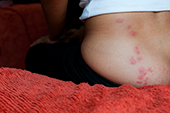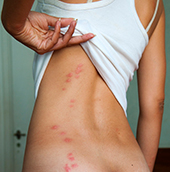|
Category |
Frequently Asked Questions |
|
|
|
Medical |
-
Are the chemicals used for bed bug treatments harmful to my health?
No, they are not, as long as you follow the label's safety instructions that are federal regulations.
-
When my unit (or home) is being treated, how long should I wait before re-entering my home?
If your home is being treated, you must leave it for at least four hours after treatment begins. It is recommended that you remain outside your home for the length of the treatment. Make other arrangements for the day (ex: stay with friends or relatives, run errands).
People with respiratory issues (who have trouble breathing), pregnant women and newborns under 18 months of age should remain outside the home for 12 hours after treatment Is completed.
-
Will there be an odour after my unit is treated?
This depends on the chemical, and kind, of treatment being used. If a contact residual treatment is used, there is little or no odour. If an aerosol treatment is used, there will be an odour.
-
What types of diseases could I get from bed bugs?
NONE.
BED BUGS DO NOT SPREAD DISEASES.
BED BUGS ARE PESTS.
|
|
|
|
|
|
Identification of Bed Bugs |
-
Why is it that I get bitten but my husband doesn't and we both sleep in the same area?
Everyone reacts differently to bed bug bites. There is a wide range of reactions, from no reaction at all to itchy red bumps.
-
What are examples of bed bug bites?
|
|
|
|
|
|
Treatment |
-
Why do some pest control companies use chemical treatment over heat treatment?
Heat treatment involves more work, time and money, Depending on the type of building (ex: high-rise apartment, multi-dwelling units), it could be impossible to stop an infestation from happening again. The difference between using chemicals, and using heat, is that chemical residual treatment is done once or twice around the suite. Heat treatment is more expensive and more immediate.
Both methods can be effective if the tenants/homeowners do their part. (ex: vacuum, steam, visual inspections)
-
What does integrated pest management mean?
Integrated pest management is a combination of chemical, mechanical, vacuum and steam treatment.
|
|
|
|
|
|
Tenants/Landlords |
-
What bylaws are related to bed bug issues or complaints?
If the City of Winnipeg's Health Department gets a complaint that a landlord is not treating for bed bugs, a notice is served to the landlord. The notice requires that the landlord hire a pest control company, with a good reputation, to treat for bed bugs. If the landlord does not heed the notice, he or she can be fined.
|
|
|
|
|
|
Self-Treatment
|
-
Why can't I use store-bought chemicals to treat my home for bed bugs?
There are health concerns about inhaling chemicals used for bed bug self-treatment, if the instructions on the product labels are not followed exactly. This is why it is best left to a qualified professional. As well, when treating for bed bug infestations, licensed pest-management professionals use different methods, depending on the type of dwelling (ex: multi-unit apartment, single-family home).
-
What can I do to help prevent bed bugs In my home?
There are many things you can do. Some examples are vacuuming, drying clothes for 20 to 30 minutes on your dryer's high-heat setting and using mattress covers. To learn more about prevention methods, see the factsheet section.
|
|
|
|
|
|
Financial
|
-
What kinds of financial programs are available for people dealing with bed bug issues?
The Provincial Bed Bug Strategy has a Bed Bug Grant program that provides assistance to community organizations on bed bug education, treatment, management and prevention. Community-based, non-profit organizations are eligible to apply for financial assistance, in the form of a grant, to a maximum of $2,000.
For more information on these programs, go to www.gov.mb.ca/bedbugs/nonprofit.html.
|
|
|
|
|
|
Materials
|
-
What kinds of materials are available to prevent bed bugs?
Through the Low Cost Preventive Bed Bug Materials Program, qualifying organizations can buy a variety of affordable, preventive items directly. Items sold through this program include:
-
bed bug mattress/box spring covers (various sizes)
-
pillow covers
-
dissolvable laundry bags
-
various insect/interceptor traps and monitors
|
|
|
|
|
|
Protecting Yourself Against Bed Bugs
|
-
Can I take bed bugs home with me if I visit a public place?
Yes. Bed bugs are hitchhikers and can be found in places/areas where people sit and sleep for long periods of time.
-
How can I protect myself from taking bed bugs home with me?
Here are some valuable tips:
-
Wash your clothes according to regular instructions, but dry them on a medium-to-high-heat dryer setting, if possible. If you're concerned about `dry clean only' items and you think you may have been in contact with bed bugs -- empty out the pockets, turn the cuffs inside out, and shake the clothing vigorously (outside your home), as bed bugs cannot grab onto things (ex: clothing).
-
If you do not have a bed-bug infestation -- regular cleaning, vacuuming and de-cluttering of your living space play an important role in preventing any future infestations.
-
If you are concerned about possible bed bugs, a monthly inspection of any sleeping/sitting areas could be done to make sure there are no signs of a bed bug infestation. For example, bed bug monitors and/or sticky traps are some tools you can use, but looking closely at the area yourself is most effective. For more information on the signs to look for when inspecting for bed bugs, go to www.gov.mb.ca/bedbugs/factsheets.html.
-
If you are entering or exiting a place that could possibly have bed bug activity (ex: movie theatres, taxis) - once you've left the area, stamp your feet, shake out any loose clothing or jackets and brush off your pants and shirts.
|
|
|


